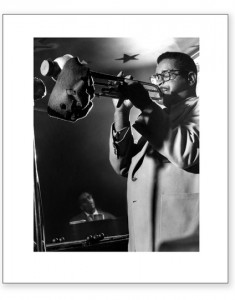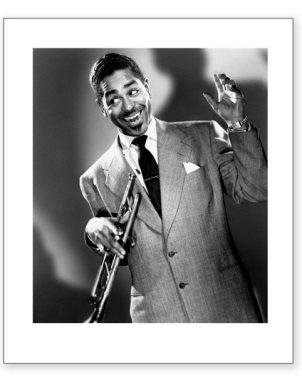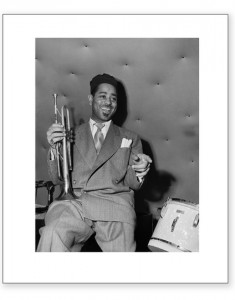Metronome Magazine: John Birks “Dizzy” Gillespie
(October 21, 1917 – January 6, 1993)
American jazz trumpeter, bandleader, composer and singer
Spearheading different movements in Jazz, from Bebop, Modern Jazz and Afro-Cuban music “Dizzy Gillespie’s contributions to jazz were huge …
Arguably Gillespie is remembered, by both critics and fans alike, as one of the greatest jazz trumpeters of all time.” Scott Yanow | AllMusic
Gillespie was a trumpet virtuoso and improviser, building on the virtuoso style of Roy Eldridge but adding layers of harmonic complexity previously unheard in jazz. His beret and horn-rimmed spectacles, his scat singing, his bent horn, pouched cheeks and his light-hearted personality were essential in popularizing bebop.
In the 1940s Gillespie, together with Charlie Parker, became a major figure in the development of bebop and modern jazz. He schooled and influenced many other musicians, including trumpeters Miles Davis, Fats Navarro, Clifford Brown, and Chuck Mangione.
Early life and career
Gillespie was born in Cheraw, South Carolina, the youngest of nine children of James and Lottie Gillespie. James was a local bandleader, so instruments were made available to the children. Gillespie started to play the piano at the age of four. Gillespie’s father died when the boy was only ten years old. Gillespie taught himself how to play the trombone as well as the trumpet by the age of twelve. From the night he heard his idol, Roy Eldridge, play on the radio, he dreamed of becoming a jazz musician.] He received a music scholarship to the Laurinburg Institute in Laurinburg, North Carolina, which he attended for two years before accompanying his family when they moved to Philadelphia.
Gillespie’s first professional job was with the Frank Fairfax Orchestra in 1935, after which he joined the respective orchestras of Edgar Hayes and Teddy Hill, essentially replacing Roy Eldridge as first trumpet in 1937. Teddy Hill’s band was where Gillespie made his first recording, “King Porter Stomp”. In August 1937 while gigging with Hayes in Washington D.C., Gillespie met a young dancer named Lorraine Willis who worked a Baltimore–Philadelphia–New York circuit which included the Apollo Theatre. Willis was not immediately friendly but Gillespie was attracted anyway. The two finally married on May 9, 1940. They remained married until his death in 1993.
Gillespie stayed with Teddy Hill’s band for a year, then left and free-lanced with numerous other bands. In 1939, Gillespie joined Cab Calloway’s orchestra, with which he recorded one of his earliest compositions, the instrumental “Pickin’ the Cabbage”, in 1940. (Originally released on Paradiddle, a 78rpm backed with a co-composition with Cozy Cole, Calloway’s drummer at the time, on the Vocalion label, No. 5467). After a notorious altercation between the two men, Calloway fired Gillespie in late 1941.
During his time in Calloway’s band, Gillespie started writing big band music for bandleaders like Woody Herman and Jimmy Dorsey. He then freelanced with a few bands – most notably Ella Fitzgerald’s orchestra, composed of members of the late Chick Webb’s band, in 1942.
In 1943, Gillespie joined the Earl Hines band.
Next, Gillespie joined Billy Eckstine’s (Earl Hines’ long-time collaborator) big band and it was as a member of Eckstine’s band that he was reunited with Charlie Parker, a fellow member of Hines’s band. In 1945, Gillespie left Eckstine’s band because he wanted to play with a small combo. A “small combo” typically comprised no more than five musicians, playing the trumpet, saxophone, piano, bass and drums.
Rise of Bebop
Known as the first modern jazz style, Bebop, was not immediately embraced by Jazz fans who loved swing music was. Bebop was seen as an outgrowth of swing, not a revolution. Swing introduced a diversity of new musicians in the bebop era like Charlie Parker, Thelonious Monk, Bud Powell, Kenny Clarke, Oscar Pettiford, and Gillespie. Through these musicians, a new vocabulary of musical phrases was created. With Charlie Parker, Gillespie jammed at famous jazz clubs like Minton’s Playhouse and Monroe’s Uptown House. Charlie Parker’s system also held methods of adding chords to existing chord progressions and implying additional chords within the improvised lines.
Gillespie compositions like “Groovin’ High”, “Woody ‘n’ You” and “Salt Peanuts” sounded radically different, harmonically and rhythmically, from the swing music popular at the time. “A Night in Tunisia”, written in 1942, while Gillespie was playing with Earl Hines’ band, is noted for having a feature that is common in today’s music, a non-walking bass line. The song also displays Afro-Cuban rhythms. Gillespie taught many of the young musicians, including Miles Davis and Max Roach, about the new style of jazz.
After a lengthy gig at Billy Berg’s club in Los Angeles, which left most of the audience ambivalent or hostile towards the new music, the band broke up. Unlike Parker, who was content to play in small groups and be an occasional featured soloist in big bands, Gillespie aimed to lead a big band himself; his first, unsuccessful, attempt to do this was in 1945.
Afro-Cuban Music
In the late 1940s, Gillespie was also involved in the movement called Afro-Cuban music, bringing Afro-Latin American music and elements to greater prominence in jazz and even pop music, particularly salsa. Afro-Cuban jazz is based on traditional Afro-Cuban rhythms.
Afro-Cuban jazz was considered bebop-oriented, and some musicians classified it as a modern style. Afro-Cuban jazz was successful because it never decreased in popularity and it always attracted people to dance to its unique rhythms.
Later Career
In 1960, he was inducted into the Down Beat magazine’s Jazz Hall of Fame.
Presidential Run
During the 1964 United States presidential campaign the artist, with tongue in cheek, put himself forward as an independent write-in candidate. Promising that if he were elected, the White House would be renamed “The Blues House,” and a cabinet composed of Duke Ellington (Secretary of State), Miles Davis (Director of the CIA), Max Roach (Secretary of Defense), Charles Mingus (Secretary of Peace), Ray Charles (Librarian of Congress), Louis Armstrong (Secretary of Agriculture), Mary Lou Williams (Ambassador to the Vatican), Thelonious Monk (Travelling Ambassador) and Malcolm X (Attorney General). He said his running mate would be Phyllis Diller. Campaign buttons had been manufactured years ago by Gillespie’s booking agency “for publicity, as a gag”, but now proceeds from them went to benefit the Congress of Racial Equality, Southern Christian Leadership Conference and Martin Luther King, Jr.; in later years they became a collector’s item.
In 1971 Gillespie announced he would run again but withdrew before the election.
Later Achievements & Events
Gillespie published his autobiography, To Be or Not to Bop, in 1979.
In the 1980s, Gillespie led the United Nation Orchestra.
Gillespie was nominated for Grammy awards.
Gillespie also had a guest appearance on The Cosby Show as well as Sesame Street and The Muppet Show.
In 1982, Gillespie had a cameo appearance on Stevie Wonder’s hit “Do I Do”.
In 1988, Gillespie had worked with Canadian flautist and saxophonist Moe Koffman on their prestigious album Oo Pop a Da. He did fast scat vocals on the title track and a couple of the other tracks were played only on trumpet.
In 1989 Gillespie gave 300 performances in 27 countries, appeared in 100 U.S. cities in 31 states and the District of Columbia, headlined three television specials, performed with two symphonies, and recorded four albums.
He was also crowned a traditional chief in Nigeria, received the Ordre des Arts et des Lettres; France’s most prestigious cultural award. He was named Regent Professor by the University of California, and received his fourteenth honorary doctoral degree, this one from the Berklee College of Music. In addition, he was awarded the Grammy Lifetime Achievement Award the same year.
The next year, at the Kennedy Center for the Performing Arts ceremonies celebrating the centennial of American jazz, Gillespie received the Kennedy Center Honors Award and the American Society of Composers, Authors, and Publishers Duke Ellington Award for 50 years of achievement as a composer, performer, and bandleader.
In 1993 he received the Polar Music Prize in Sweden.
November 26, 1992 at Carnegie Hall in New York, Gillespie’s 75th, Gillespie was to appear at Carnegie Hall for the 33rd time but didn’t make because he was in bed suffering from cancer. The musicians that appeared that night all paid tribute to Gillespie. Gillespie died of pancreatic cancer less than two months later on January 6, 1993.
Check out all Fine Art Prints of Dizzy Gillespie available on Limited Runs
“Dizzy Plays” by Frank Kuchirchuk

Photo Taken: c.1945
Taken during rehearsal for a performance in Los Angeles.
Year Photo Taken: Jan. 17, 1946
Billy Berg’s Club
Billy Berg (d. 1962) had owned several other Hollywood jazz clubs prior to opening his Vine Street location. These included the Capri Club (Pico and La Cienega), the Trouville (Beverly and Fairfax), and the Swing Club (Hollywood and Las Palmas). Billy Berg’s was noted as one of the first integrated jazz clubs in Hollywood.
Today the original building still stands at the corner of Vine Street and De Longpre Avenue.
Dizzy Gillespie Quintet Debut
The Vine Street club was most noted for booking the Dizzy Gillespie Quintet, an engagement that lasted from Monday, 10 December 1945 to Monday, 4 February 1946. This was the first appearance for both Gillespie and Charlie Parker on the west coast. Along with Gillespie and Parker, the quintet was composed of Al Haig on piano, Ray Brown on bass, and Stan Levey on drums. Milt Jackson was added to the quintet due to Parker’s unreliable attendance. On the first night of the engagement Parker did not take to the stage until late in the second set, making his way through the audience while playing “Cherokee.” Contrary to what was shown in the film Bird, Parker had been in the back of the club eating the club’s specialty Mexican food for the first part of the concert.
Live Recordings
One recording exists of the Gillespie band (with Lucky Thompson added) at Billy Berg’s. “Salt Peanuts” was recorded for a WEAF radio broadcast on 24 January 1946.
Reference: Wikipedia
Back to Artist List
Back to Metronome Main Page


